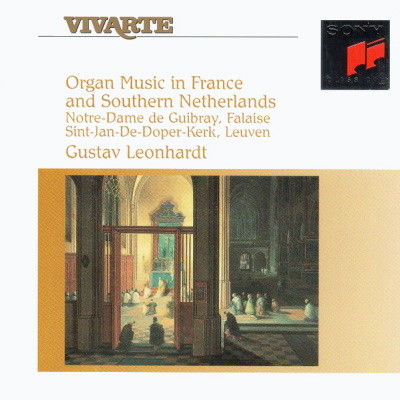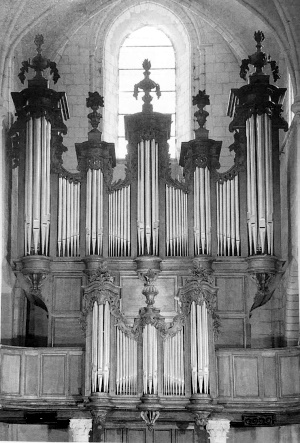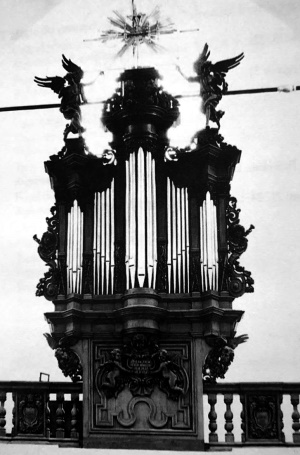 |
1 CD
-SK 57 963 - (p) 1994
|
|
ORGAN MUSIC IN
FRANCE AND SOUTHERN NETHERLANDS
|
|
|
|
|
|
|
|
|
THE PARISOT
ORGAN IN NOTRE-DAME DE GUIBRAY, FALAISE
(NORMANDY)
|
|
|
|
| Jacques BOYVIN (c.1649-1706) |
Suite
du premier ton in D from "Premier livre
d'orgue" |
|
14' 18" |
1 |
| Jean-Adam Guillaume
GUILAIN (fl.1702-1739) |
Suite
du second ton in g |
|
11' 17" |
2 |
|
THE PETER
GOLTFUSS ORGAN IN SINT-JAN-DE-DOPER,
BEGIJNHOFKERK, LEUVEN (BELGIUM)
|
|
|
|
| Johann KRIEGER
(1652-1735) |
Passacaglia
in D minor |
|
3' 10" |
3 |
| Abraham van den
KERCKHOVEN (c.1618-1701) |
Fantasia
in D minor |
|
5' 36" |
4 |
|
Fantasia
in F major |
|
7' 26" |
5 |
| Johann Kaspar KERLL (1627-1693) |
Canzona
in E minor
|
|
2' 49" |
6 |
| Carl LUYTHON
(c.1557-1620) |
Fuga
suavissima in G major |
|
5' 39" |
7 |
| Johann Jacob
FROBERGER (1616-1667) |
Toccata
V da sonarsi alla levatione in D minor
|
|
4' 51" |
8 |
|
Capriccio
II in A minor |
|
4' 22" |
9 |
|
Canzona
VI in a
|
|
3' 11" |
10 |
| Lambert CHAUMONT (c.1630-1712) |
Deuxième
ton (Pièces d'orgue) in g |
|
6' 42" |
11 |
|
|
|
|
|
Gustav
Leonhardt, Organs
- Parisot Organ in Notre-Dame de
Guigray, Falaise (Normandy) - Pitch: a' =
415 Hertz
- Peter Goltfuss Organ in
Sint-Jan-de-Doper, Begijnhofkerk, Leuven
(Belgium) - Pitch: a' = 398 Hertz
|
|
|
|
|
|
Luogo
e data di registrazione |
|
Notre-Dame de
Guibray, Falaise, Normandy
(France) - 13 Settembre 1993 (1,2)
Sint-Jan-de-Doper, Begijnhofkerk,
Leuven (Belgium) - 2/3 Marzo 1993
(3-11)
|
|
|
Registrazione:
live / studio |
|
studio
|
|
|
Producer /
Recording Supervisor |
|
Wolf Erichson
|
|
|
Recording
Engineer
|
|
Stephan Schellmann
(Tritonus), Andreas Neubronner
(Tritonus)
|
|
|
Prima Edizione
LP |
|
Nessuna
|
|
|
Edizione CD |
|
Sony "Vivarte" | LC
6868 | SK 53 963 | 1 CD - durata
70' 03" | (c) 1994 | DDD
|
|
|
Original Cover
|
|
"Celebration of the
Mass in a Catholic Church" by
Hendrik van Steenwijk (1580-1649).
|
|
|
Note |
|
-
|
|
|
|
|

The Parisot Organ in
Notre-Dame de Guibray,
Falaise (Normandy)
Few Normandy organs have
survived the vicissitudes of
time as well as Claude and
Henri Parisot's 1746
instrument at Falaise. The
case, action, console, all
the windchests with the
exception of the Positif and
the majority of the stops
are all eighteenth-century
originals.
In all likelihood there was
already an organ at
Notre-Dame de Guibray in the
Middle Ages. A contract
survives from 1537
commissioning the Normandy
builders Gratien de Cailly
and Simon Le Vasseur to
build a new organ. This
instrument appears to have
been damaged during the first
of the Huguenot Wars, since
it had to be restored as
early as 1565. At the same
time, de Cailly was
instructed to move the organ
from a gallery in the
transept to the back of the
nave.
The first mention of an
organist (one Dauphin by
name) and his bellows blower
is found in archival records
from 1714. Three years later
the same records list repair
costs for the organ but give
no further details about the
builder in question. Clearly
the instrument was already
in a poor state of repair by
this date since, in 1745,
the parish decided to have a
new organ built. The
brothers Jean and Joseph Le
Roy were commissioned to
build a new gallery.
Receipts show that the new
instrument was built in 1746
by Claude Parisot and his
nephew Henri, who was then
twenty years old. Claude
Parisot (1704-1781) hailed
originally from Lorraine and
had already made a name for
himself with his work in the
churches of St. Remy in
Dieppe and St. Sépulcre at
Abbeville, as well as the
Premonstratensian abbeys at
Mondaye and Ardenne, the
cathedral at Sées and the
Dominican monastery at Caen.
The organ case and
balustrade at Notre-Dame de
Guibray are the work of
Jacques Chapelain, who also
built the structurally
similar case of Parisot’s
organ in Sées Cathedral.
The Falaise instrument was
not regularly maintained,
with the result that Claude
and Henri Parisot were
required to carry out
repairs in 1755, 1768 and
1769. The position of
organist was held at this
time by Jacques Noël
Toustain, who occupied the
tribune from the date at
which the new organ was
installed until his death in
1771. His successor was a
certain Sieur Fleury, who
was replaced in turn in 1775
by an organist called
Gervais. Henri Parisot
remained responsible for the
organ’s upkeep until the
Revolution. Although the
church was used to store
animal fodder from 1792
onwards, the organ continued
to be played at secular
festivities.
Neither the church nor its
organ survived the
Revolution unscathed. Urgent
repair work was necessary
when, following the
Concordat of 1801,
Notre-Dame de Guibray was
once again available for
religious services.
Moreover, no fewer than 146
pipes were missing. An organ
builder by the name of
Linsel (or Lincel) carried
out a series of minor
repairs over the ensuing
years, but it was not until
1833 that the Claude
Brothers from Mirecourt in
the Vosges began a
relatively extensive
overhaul, which they were
able to complete only in
1838, following a number of
financial problems on the
part of the local parish. In
the course of this work
three of the old stops were
rebuilt: the Trompette and
Clairon in the Grand Orgue
and the Clairon in the
Pedal.
In 1886 Joseph Koenig
overhauled the instrument,
prior to carrying out a
complete restoration in
1900/01, including an
overhaul of the Positif and
the addition of an
I-Iautbois stop. His son
Paul-Marie undertook some
minor repairs in 1920.
Shortly before the Second
World War Parisot’s historic
instrument narrowly escaped
a fatal rebuild by a wholly
unqualified builder, but the
church was badly damaged by
air raids and the organ
itself was affected, with
the result that it was no
longer playable. In 1955 it
was declared a listed
monument, a status extended
to the organ case some
fifteen years later.
Restoration work on the
instrument was delayed until
1970, when the task of
rebuilding the Notre-Dame
organ was entrusted to Erwin
Muller of Croissy-sur-Seine.
He carried out the work in
the spirit of French
Neo-Classicism, a style
which left its mark above
all on the instrument’s
tonal qualities. Neither the
type of construction nor the
material used for the new
pipes was in keeping with
the organ’s original design.
The composition of the
Mixtures and a few
additional pedal stops were
clearly influenced by the
spirit of the age.
In consequence, a new
overhaul was necessary by
the 1990s. Between 1991 and
1993 the firm of Boisseau et
Cattiaux of Béthines near
Poitiers restored the
instrument to its original
state, overhauling all the
pipework, replacing the
newer pipes by historical
reconstructions, removing
the modern pedal stops,
replacing the parallel
bellows with wedge-bellows,
opting for a composition of
Mixtures based on Dom Bédos
and restoring the original
pitch (a' = 415 Hertz) and
the irregular temperament
prescribed by Michel
Corrette and typical of the
mid-eighteenth century.
Following its most recent
restoration, the organ at
Notre-Dame de Guibray
provides valuable evidence
of the art of
eighteenth-century organ
building, while at the same
time constituting the best
preserved of Parisot’s
instruments. As such, this
historic and sensitively
restored instrument is
admirably suited to
performing French music of
the seventeenth and
eighteenth centuries.

The Peter Goltfuss Organ
in the Beguine Court
Church of St. John The
Baptist at Leuven
(Belgium)
The Goltfuss organ in the
Church of st. John the
Baptist in the Great Beguine
Court at Leuven is one of
the best preserved of
seventeenth-century
instruments. It is clear
from a recently discovered
contract that the organ
builder Peter Goltfuss was
commissioned to build a new
organ for the Beguine Court
Church in 1690.
The Goltfuss family of organ
builders enjoyed a high
reputation in Brabant and
Flanders at this time. The
head of the dynasty, Hans
Goltfuss, came originally
from Keulen, but had settled
in Haacht around 1642. He is
known to have helped in
building the organ in St.
John's Cathedral in
’s-Hertogenbosch, to have
undertaken restoration work
on the instruments in St.
Peter’s in Leuven and Park
Abbey at Heverlee and to
have built the new organ in
the Abbey of Our Lady of the
Vineyard in Leuven. He died
in 1658, leaving a
six-year-old son, Peter, and
a widow, who married his
master-journeyman, Jan
Dekens. Dekens ran the
business until Peter
Goltfuss was old enough to
take it over. From this
period date the organs in
Averbode Abbey and St.
Germanus’s in Tienen.
Only two organs by Peter
Goltfuss (1652-i697) are
known to have survived: the
organ in the Augustinian
Abbey of St. Maartensdal at
Leuven, now in Longueville,
and the organ from the
Beguine Court Church in
Leuven that can be heard in
the present recording. This
last-named instrument was
completed in 1696 and shows
the influence of Hans
Goltfuss, with its large
central tower positioned
between two pipe flats which
are framed, in turn, by two
smaller towers with dummy
display pipes. The
substructure of the oak case
rests on the gallery
balustrade. Like the
Goltfuss organ in
Longueville, the Leuven
instrument is decorated with
ornate carvings. In spite of
extensive enquiries, it has
proved impossible to
identify the artist
responsible for the Baroqug
cas.
Between 1857 and 1860 P. A.
van Dinter of Maaseik
undertook substantial
rebuilding work on the
Leuven Goltfuss organ,
although it is obvious from
early nineteenth-century
engravings that changes to
the Larigot pipes had
already been made at an
earlier date. In accord with
contemporary taste, van
Dinter increased the wind
pressure, redesigned the
feet of the pipes and raised
the pitch by altering both
the length of the pipes and
the height of the cutup.
Stops which he regarded as
"too shrill" he replaced by
Romantic voices such as
Viola da Gamba 8' and
Dulciana 4’ and restor the
Trompette, which was divided
into bass and treble. The
compass of the keyboard was
extended to g"' by
incorporating additional
chests.
During the twentieth century
the instrument was
maintained by the firm of
Van de Loo. Electric bellows
were installed but proved
too noisy. Following
substantial restoration of
the Beguine Court Church,
the parish decided to have
the organ overhauled, too.
Since much of the original
instrument had survived, the
builder G. Potvlieghe-De
Maeyer of Ninove was able to
restore Goltfuss’s
instrument to its original
state. In the course of the
work, which lasted from 1983
to 1986, it was discovered
that the old wind supply,
with its three wedge-bellows
and hand pump, still
existed. This can now be
used as an alternative to
the restored electric
bellows. Potvlieghe-De
Maeyer also restored the
keyboard, which now has a
compass of C - c''' with a
short first octave. The
pedalboard (C - c), which is
coupled to the manual, was
reconstructed on the model
of the Goltfuss organ in
Longueville. The low notes
here are arranged not
according to the principle
of the short octave (with
the keys of E, F-sharp and
G-sharp playing C, D and E
respectively) but in
chromatic order, a system
found in a number of Spanish
instruments. The opportunity
was also taken to retum the
stoplist to its original
state. Tuning and voicing
were undertaken in
collaboration with A.
Fauconnier and K. Van der
Linden (Netherlands).
Meantone was adopted, and
the present pitch is around
three-quarters of a tone
lower than modern a‘ = 440.
Peter Goltfuss’s instrument
in the Beguine Court Church
in Leuven is the first organ
in Brabant to be rigorously
restored using the latest
insights into the type of
construction and tonal
picture of
seventeenth-century organ
building. In consequence,
the instrument is a unique
example of the type of organ
being built in South Brabant
at that time and is thus
particularly well suited to
performances of works by
Flemish composers such as
Lambert Chaumont and Abraham
van den Kerkhoven.
Dorothee
Hütte
(Translation:
© 1994 Stewart Spencer)
|
  |
|
|